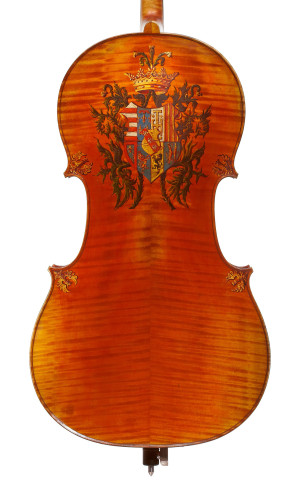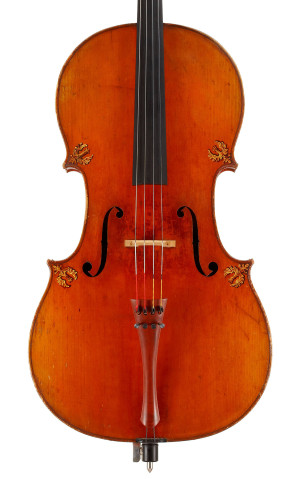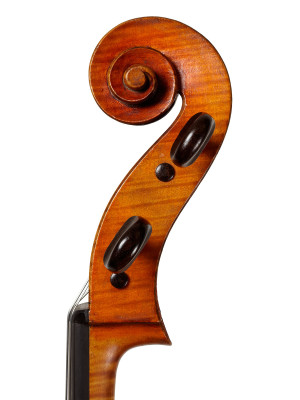 The French fascination with decorated instruments emerges with the earliest works of Andrea Amati brought from Cremona for King Charles IX in the 1560s. The tradition continued into the reign of Henry IV, and the occasional early French cello is known emblazoned with the motifs of Louis XIV, the Sun King. There is occasional evidence for the tradition in the 18th century, but it emerged again after the French Revolution. At the Paris Conservatoire, violins and cellos were painted when they were given as prizes. These ‘Premier Prix’ could include older instruments, and even the occasional Amati fell under the commemorative brush, but examples by Nicolas Lupot date the revival to the 1810–20s, establishing the beginnings of a 19th-century tradition.
The French fascination with decorated instruments emerges with the earliest works of Andrea Amati brought from Cremona for King Charles IX in the 1560s. The tradition continued into the reign of Henry IV, and the occasional early French cello is known emblazoned with the motifs of Louis XIV, the Sun King. There is occasional evidence for the tradition in the 18th century, but it emerged again after the French Revolution. At the Paris Conservatoire, violins and cellos were painted when they were given as prizes. These ‘Premier Prix’ could include older instruments, and even the occasional Amati fell under the commemorative brush, but examples by Nicolas Lupot date the revival to the 1810–20s, establishing the beginnings of a 19th-century tradition.
France under Napoleon was keen to compare the present state of the country to the golden periods of its history as a way of looking beyond the recent revolutionary past. The royal coat of arms of ‘France Moderne’ in the 16th century had become the emblem of the newly restored Bourbon monarchy in 1814, and these arms are found upon Lupot’s violins in conscious reference to the earlier period. By 1830 the young Jean-Baptiste Vuillaume and Honore Derazey were producing extravagantly decorated violins in an antique style, intended to represent the fictional father of the violin in France, Gaspard Duiffprougcar, with finely painted coats of arms on the upper part of the back. More even than Amati’s work, these purported 16th-century instruments set the tone for decoration throughout the rest of the 19th century. Among Vuillaume’s masterpieces are his quartets made for Count Doria, Prince Carman de Chimay and Prince Cheremetoff – all decorated to reflect this style. Other similar instruments by Vuillaume were made for noble Russian families, including a violin and octobass made for Czar Nicholas I in 1840.

After Vuillaume’s death in 1875 French violin makers who had worked in his shadow scrambled to assert themselves as his successor. Just as Vuillaume had built his own reputation as a medallist at industrial exhibitions in France and worldwide, Pierre Charles Jacquot had already established himself with a first-prize at Metz and a bronze medal at Paris. He won the prize medal at the 1862 International Exhibition in London, where Vuillaume had been a juror, and the great gold medal in Lyons in 1872. This cello, made around 1888, consciously attempts Vuillaume’s standards, using the Stradivari model that he had adapted. Like Vuillaume, Jacquot reserved the painted decoration for his very best instruments, and it is probable that it was made as part of a quartet. An accompanying violin was sold at auction in France some years ago and another violin is reported to survive in a French museum. The coat of arms on the back is not for a noble family but for the city of Nancy, where Jacquot spent his entire career. In the following year he was awarded silver medal at the Exposition Universelle in Paris, where the judges remarked upon his instruments of ‘beautiful pattern’ with ‘varnish copied from that on old instruments, the equality of tone being remarkable’. It is tempting to imagine that this was part of a quartet of instruments that won him that medal. It certainly reflects the mindset of a maker fixed on such achievement. In 1892 he received the Croix de la Legion d’Honneur.

![]()